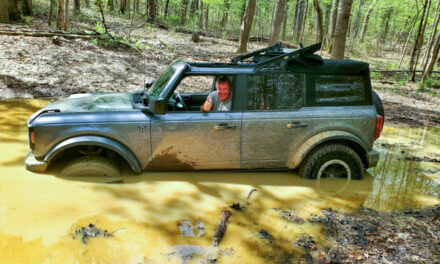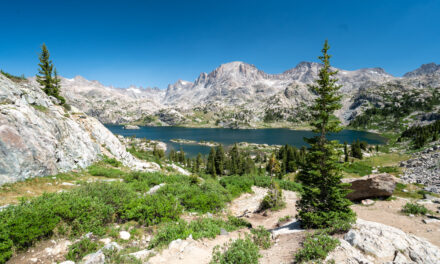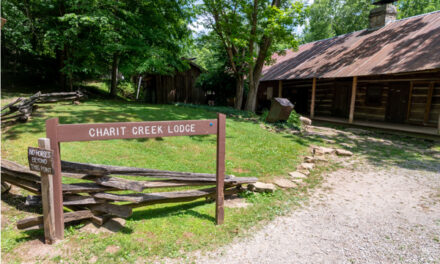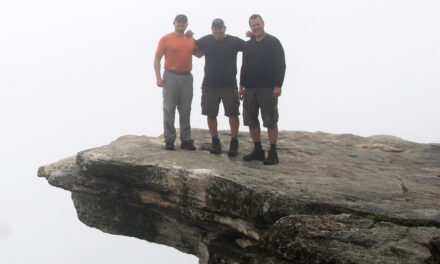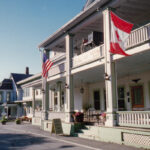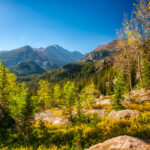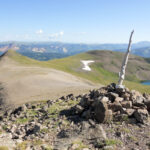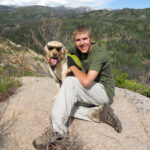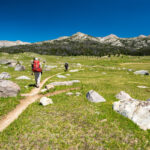Boundary Waters Canoe Area Wilderness – June 2021
Boundary Waters Canoe Area Wilderness
18
JUNE, 2021
A canoe trip in Minnesota’s Boundary Waters Canoe Area Wilderness has occupied a spot near the top of my ‘Bucket List’ for a long time. The opportunity finally presented itself in June 2021 when Rick, a former co-worker, invited me to accompany him on a 6-day Boundary Waters trip. I jumped at the opportunity but also had some trepidation about what I had gotten myself into. I was a nube on water, and I had jumped right into the canoeing Big League.
Background and talk with Bob
I had never been to the Boundary Waters Canoe Area Wilderness in far northern Minnesota, but it played an essential role in my early backpacking days. As a potential trip destination, the Boundary Waters had always been on my mind. When I first started backpacking, I had long conversations with Bob, a manager on my staff. We would talk about all things backcountry camping and gear. Bob was a veteran of many Boundary Waters trips. I ‘picked his brain’ for tidbits of knowledge every chance I could. Bob even had a massive map of the Boundary Waters on his office wall. He would explain his previous trips as we examined the map. I loved every minute of it and took his many words of wisdom and tales of paddling adventure to heart.
The drive to Minnesota
We started the long drive to Minnesota on the night before we were to check in at the Seagull Outfitter. The outfitter is located 57 miles up the Gunflint Trail from Grand Marais, Minnesota. Seagull Outfitter would provide our canoe, Duluth pack, life vests, and a bed in the bunkhouse, and a ‘tow’ (boat ride) to our starting point at America Point on Saganaga Lake. As we crossed the bridge into Minnesota, the weather was rainy and gloomy. It was predicted to continue that way into the next day. But, thankfully, the forecast was for clearing skies just in time for us to start paddling. Johnny cash played on the radio as we turned left onto the Gunflint Trail. Then another stop at the Clearwater Outfitters, home of Rick’s favorite podcast, Tumblehome. Finally, the Chik-Wauk Museum, which has a great display of historical artifacts from the local area.

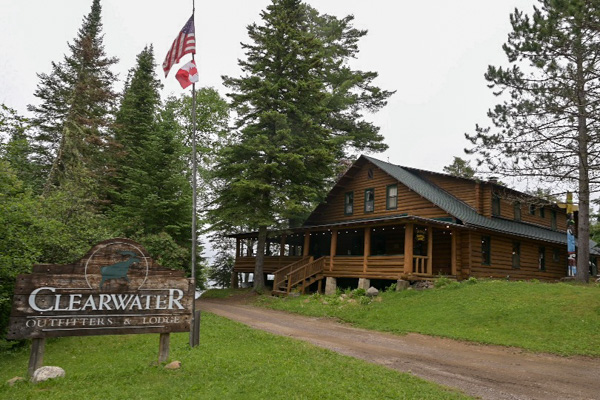

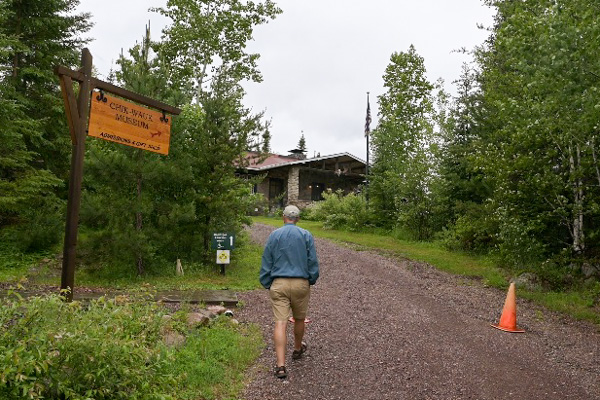
Arrival at Seagull Outfitter
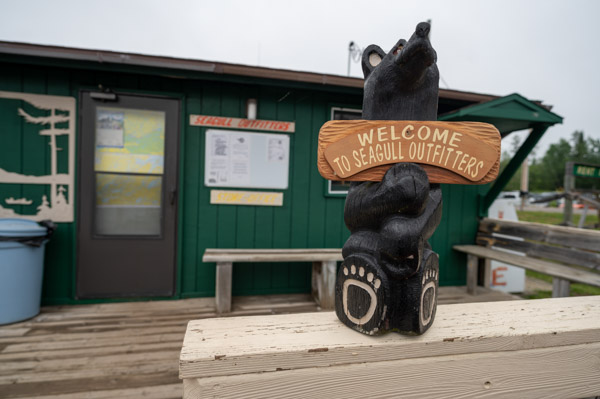
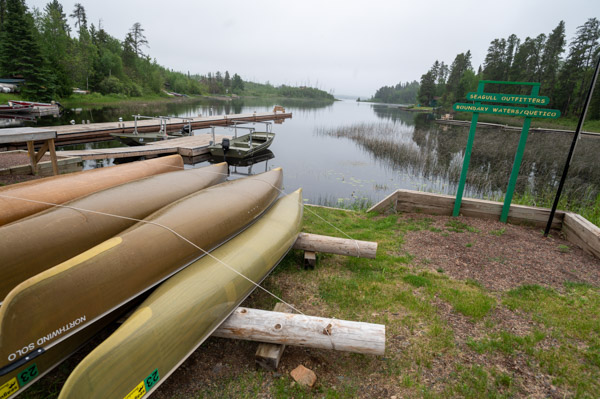
With the trip’s tourist activities completed, we headed to the Seagull Outfitter, which sits at the very end of the Gunflint Trail National Scenic Byway. The drive from Grand Marais on the Gunflint Trail is beautiful and a showcase of northern Minnesota backwood forest country. Mile after mile of dense northern forest broken up by one scenic lake after another. It gave us a good feel for what we would be paddling in over the next six days. We picked up our gear at the Outfitter and bought some last-minute supplies. Outfitter staff gave us a much-needed briefing on our intended route, including fishing conditions and information on campsites. We headed across the street to the bunkhouse to get going on packing.
Exploring the area and first look at Saganaga
A healthy rainstorm rolled in out of nowhere right when we got to the bunkhouse parking lot. Heavy rain chased us into the car for about 15 minutes. It gave us ample time to think about being caught in that type of storm out in the exposed canoe! We hoped the forecast of much-improved weather starting the next day would be accurate. The first night in the woods of Minnesota ended with a hike on the Blueberry Hill trail back at the Chik Wauk Museum. The summit of the trail gave us our first look at the start of our paddling route and Saganaga Lake in the distance. It felt great to have the grueling travel portion of the trip behind us, as well as the bulk of packing. We celebrated with a sip of wine and a toast to a great trip.

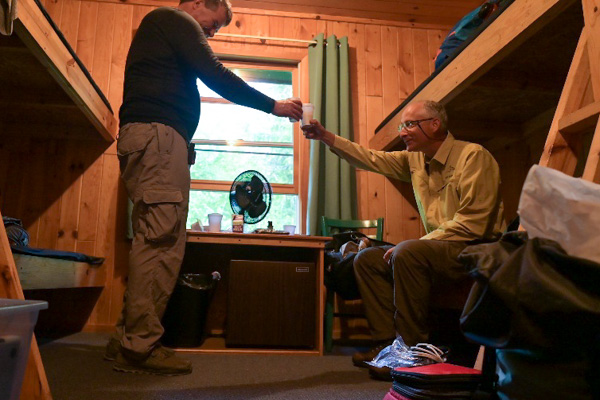
First day in the Boundary Waters – to Otterback Lake
Morning at Seagull Outfitter and prepping for the first day
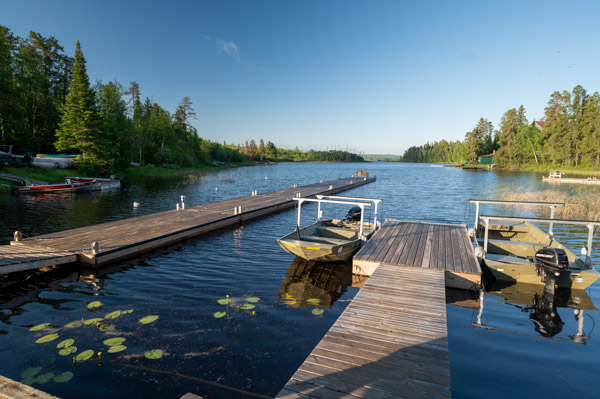
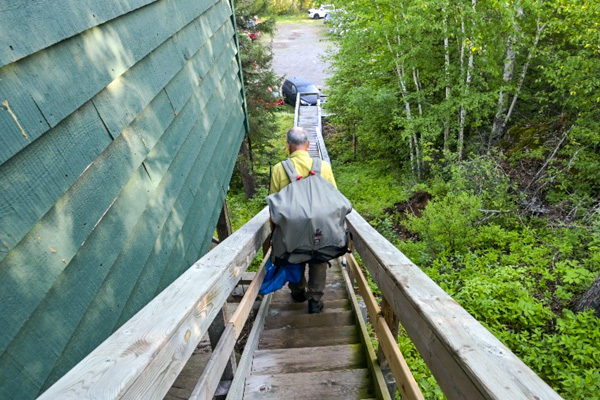
The forecast was accurate, and the skies were clear the following day. Air temperature was cold and crisp. It was a gorgeous morning, and we were chompin’ at the bit to get started. As we waited for everyone to assemble, Rick and I strolled out to the end of the dock to ponder our arrival at that exact spot six days later. We couldn’t help but think about what adventures, both good and bad, would be in store. Rick took one for the team and carried the 100+ pound Duluth pack down the bunkhouse stairs and over to the vans. That bulging pack was a clear indication that this would not be any ‘ultralight’ trip! The weight would only be a minor burden while paddling, but carrying it on the portages would be a different story.
Tow to American Point on Saganaga
Seagull Outfitter staff had already loaded all the canoes on trailers. They would be towed behind vans that would shuttle everyone to their starting points. After what seemed like an eternity, the last stragglers finally arrived. We piled in our designated vans and headed out. The excitement and the nerves were building in equal proportions! It had been a long time since I’d spent any significant time in a canoe, and never on the type of ‘big water’ we would be experiencing starting the trip to Saganaga Lake. The ‘tow’ out to American Point did nothing to calm my nerves. Waves were large (~2 feet) and pounded the small towboat. I couldn’t imagine how we could paddle a canoe in that type of rough water. We were also going to be paddling straight into a 20+ MPH wind. Ouch!
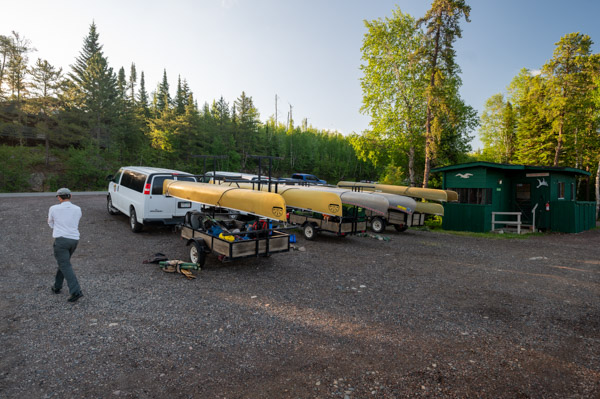

Paddling the ‘big water’ on Saganaga on the first day


The tow arrived at American Point, and in a few minutes, we were on our own. Ooh, baby, I was nervous! When we first started paddling, I felt awkward and tense in the unstable fiberglass canoe. That was despite our spending some ‘practice’ time in the canoe the day before at the outfitter. Every muscle in my body was tense. I tried to paddle while not moving my center of gravity to avoid rocking the canoe. Fortunately, the first 1/4 mile was sheltered from the wind. It gave me a brief opportunity to get a bit more comfortable. But all too soon we rounded the corner and came straight into the teeth of the wind. The waves on Saganaga were large enough to go over the side of the canoe. That was more than a little unnerving. Yikes!
My muscles weren’t yet used to the constant paddling, and started to feel crampy. But the wind was so strong if we stopped paddling, even briefly, we went backward! It was the toughest paddling of the whole trip. After two grueling hours, we came to our first portage. Thankfully it was only about 100 feet long—a good one to start with.
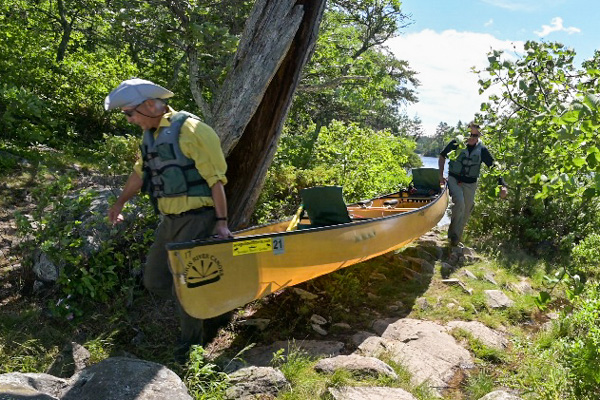
First portages in the Boundary Waters
This first portage took us into Swamp Lake. We were now off the ‘big water’ of Saganaga Lake. The paddling immediately became downright pleasant, with the narrow lake sheltering us from the wind. Our route took us right down the USA-Canada border, which sat at the center point of the lake. The right shore was Canada, the left USA. Shiny metal boundary markers lined the Canadian shore. Our 2nd portage, the Monument Portage, was the real deal. 0.3 miles up a steep hill and then down the other side to Otterback Lake. Later in the trip, we would handle these portages efficiently in a ‘single portage’ (get everything done with one trip). But this early in the journey, we struggled with ‘double portages’ (two trips to shuttle everything, plus canoe). The portage took about an hour to complete.
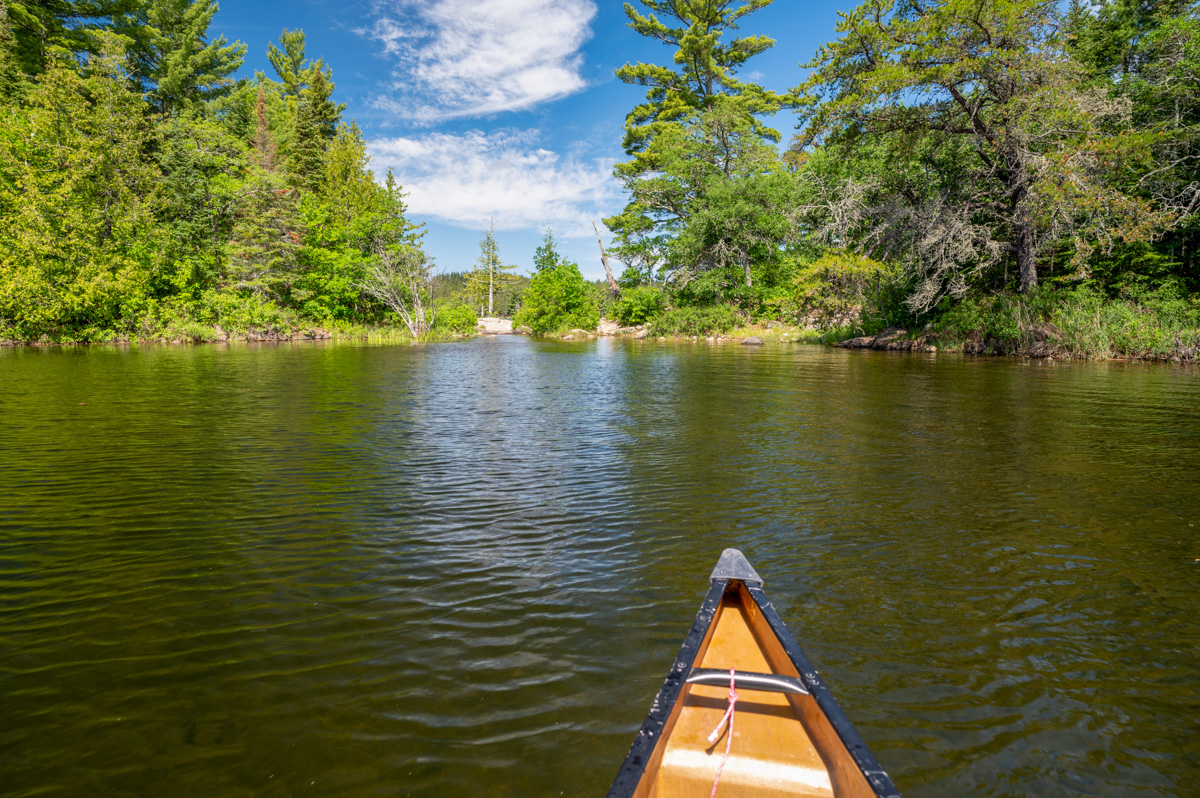
Brutal headwind and looking for a first campsite
The wind again hit us full force after starting down Otterback Lake. We paddled straight into it. It was brutal, and by this time, we had been paddling for six hours! I was exhausted. As the search for a campsite began, we had a bigger problem. All the campsites we passed were full. Paddling by a plaque honoring Benny Ambrose, the last person to live in the Boundary Waters, we were down to one last campsite possibility on Otterback. My mental and physical state was not good. After passing five occupied campsites, I had little hope we would find the last one empty. If it were occupied, we would have to do one more portage and start the campsite search all over again on Knife Lake. Not a welcome possibility. We rounded the last turn to the campsite and found it available! Halleluiah!
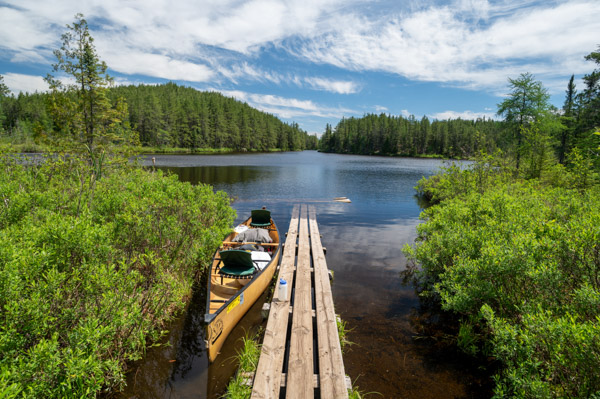
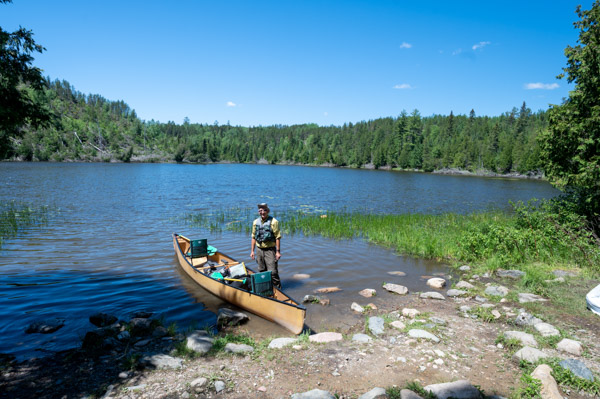
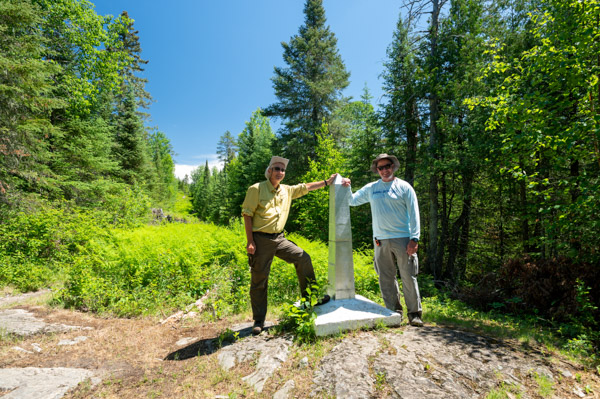

Enjoying the first campsite on Otterback Lake
It always feels good to get into camp. But after having paddled for seven hours, I kissed the ground when we got out of the canoe. Being on solid ground and finding our home for the night was heavenly. The wind continued unabated and howled through the trees. From our heavenly terra firma perch, we could see wind gusts cause small white caps on the water. Watching the passing canoes struggle against it from our camp was a satisfying experience. Much better than earlier when we were battling that same wind for forward progress in the canoe. We relaxed and recovered, and Rick did some fishing from shore. Our first dinner was incredibly satisfying – steak and baked potatoes over the fire. After dinner, the wind died down, and the water on Otterback was calm as glass.

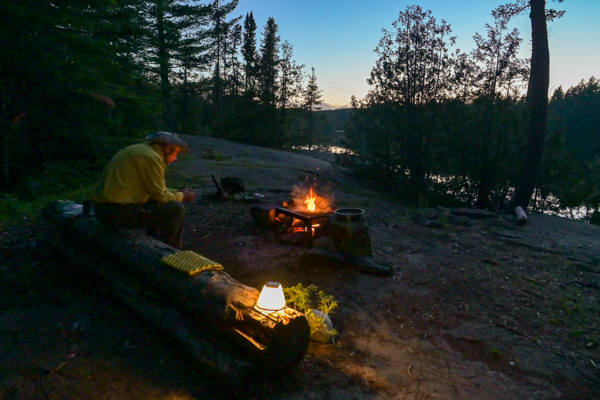
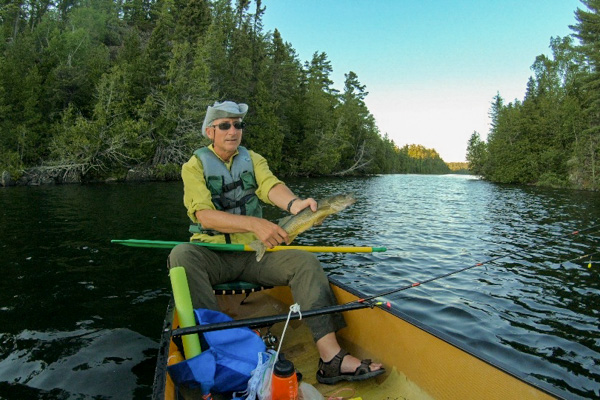
We decided to take advantage of the calm winds and perfect first evening in the Boundary Waters. Rick and I went on an enjoyable fishing cruise, during which I caught two 19-inch Walleye in close succession. Still full from dinner, we released the lucky Wallies into the water. It was a long, exhausting, and mentally challenging first day, but we had survived.
2nd day in the Boundary Waters – Heading to South Arm
First morning in the Boundary Waters – portage to Knife Lake
The following day, our first morning in the backcountry of the Boundary Waters, dawned cloudy and grungy. Thankfully, there was just a slight breeze on the morning of this second day. Breakfast was french-press coffee, eggs, bacon, bagels with cream cheese, and smoked salmon. The thought crossed my mind that I could quickly get used to this ‘real food’ canoeing! We broke down camp and packed up the canoe. Within minutes after starting to paddle, we came to our first portage of the day. Thankfully, it was a short one taking us into Knife Lake.

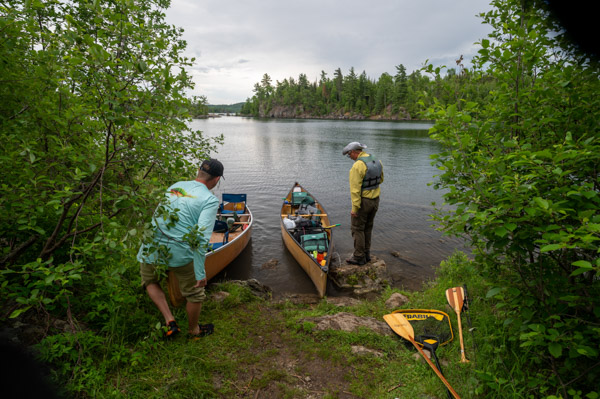

Carrying the canoe on a portage for first time
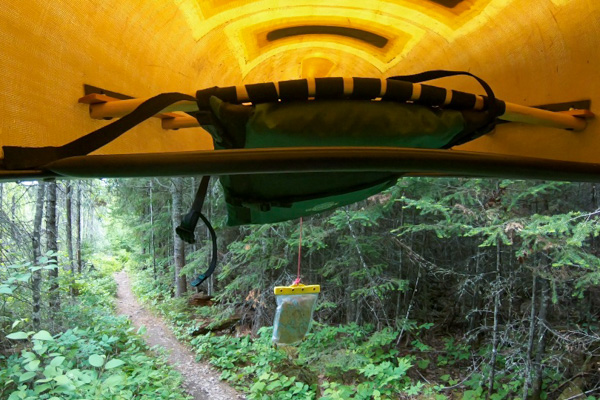
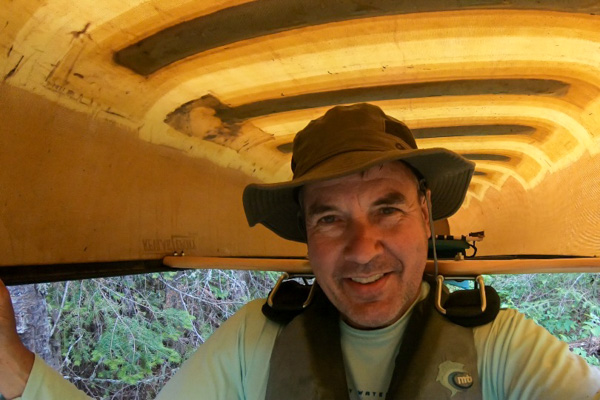
I had my first experience carrying the canoe on a portage on the second day of the trip. It was a bit bizarre but considerably easier than I had expected. When renting a canoe, you have a choice of aluminum or kevlar. The kevlar canoe weighs 47 pounds versus 70 pounds for an aluminum canoe. The downside is kevlar canoes are more expensive to rent and much more fragile than aluminum. Kevlar can be easily damaged (holes punched in it!) on the many rocks encountered at each portage. The canoe has shoulder pads at the center, and the balance when carrying the canoe on these pads is outstanding. The view is restricted, and hiking with the canoe on the rough portage trails was challenging.
2nd campsite in the Boundary Waters – South Arm Knife Lake
The last portage of our 2nd day took us into South Arm Knife Lake. The Paddle Planner website provides ratings for each campsite in the Boundary Waters. We headed for a nearby ‘5-star’ site. After 20 minutes of paddling, we arrived at the site and were stunned to find it unoccupied. Good timing is everything in searching for campsites in the Boundary Waters. With weather moving in, the first order of business was setting up the Zpacks DCF Tarp. The tarp was up just a few minutes before the first storm rolled through. We had the somewhat twisted pleasure of watching canoes paddling by in the storm. They were all looking for campsites, and we watched from our dry shelter. The plan was to stay two nights on South Arm. The mood was relaxed and a bit triumphant.
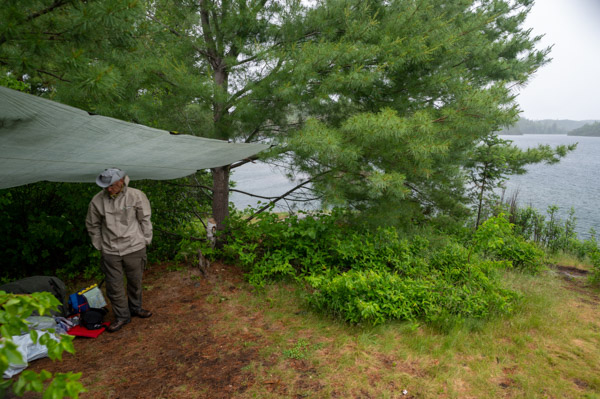
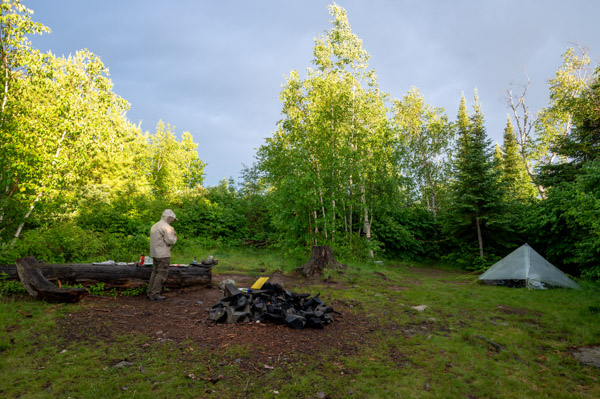

The day had been relatively easy, especially in contrast to our first day. Knowing we had two nights at that campsite made us very happy! Dinner was again scrumptious real food. Pizzas toasted in the frypan with all the fixins. I was enjoying the ‘real food’ aspect of canoe camping. The weather was crazy – stormy, blue skies, and then stormy again.
Bizarre weather in the Boundary Waters
The weather that first day at South Arm Knife Lake was bizarre. It went from sunny and clear when we first pulled in to nasty thunderstorms under the tarp. Then quickly back to perfectly cloudless skies. Next came scary-looking squall-line thunderstorms. And finally, clearing skies near sunset. The weather was too unpredictable to head out fishing that night. We knew we had a couple of days at that site, and there would be ample opportunities for fishing. The weather ‘mood swings’ made for some good photo moments. The afternoon was spent with equal time under the tarp, combined with time spent doing the various required camp chores. After our rough first day, the second day was like a refreshing breath of fresh air.
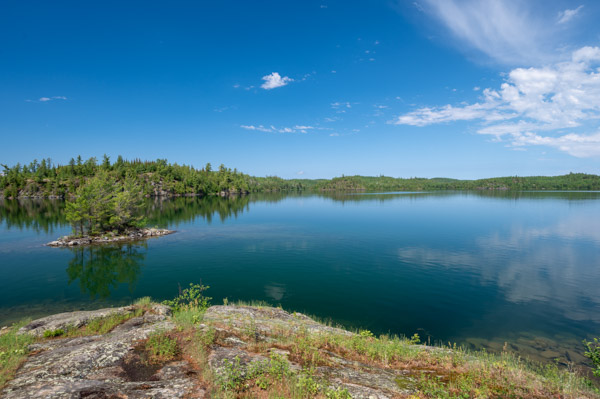
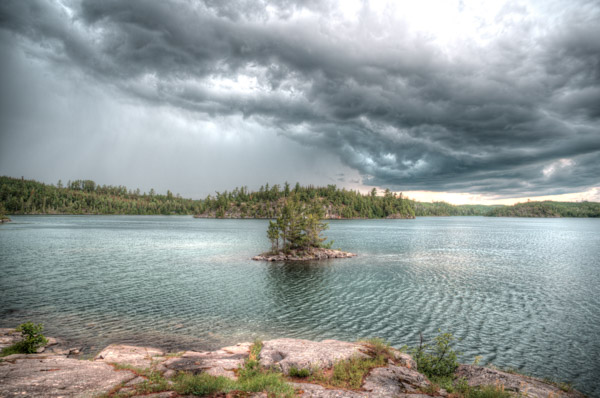
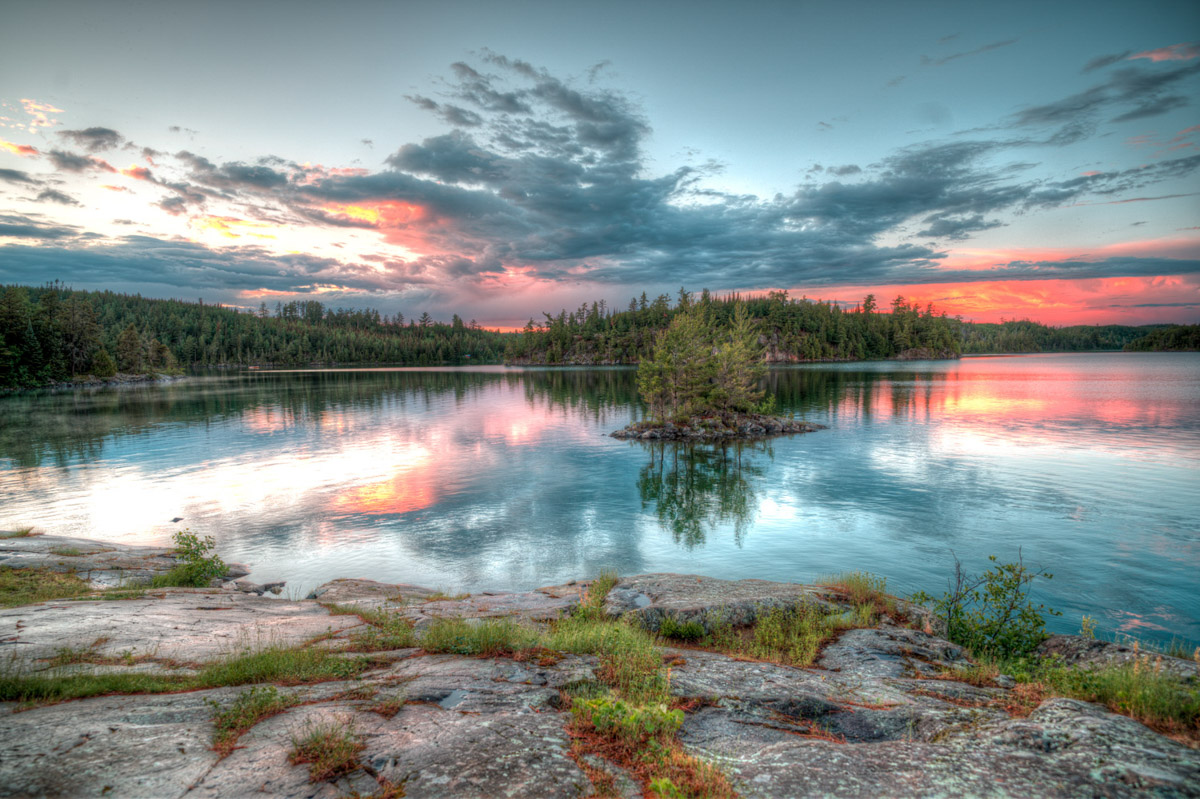
We were in a 5-star campsite we didn’t have to work hard to find. The paddling had been shorter and far less strenuous. Nature was putting on a great ‘TV show’ to entertain us. Many canoes passed by our site in the rain, looking for their camp for the night. Seeing them, we had mixed emotions. Happy with our spot but sad they were still looking.
Third day in the Boundary Waters – Day paddle to Thunder Point
Relaxed breakfast at South Arm – paddle to Thunder Point
The morning of our third day was cloudy, and it had the look of approaching rain. That morning we had the luxury of staying put in our 5-star campsite. After our first two long days of travel, it felt terrific knowing we had a day off from paddling. Well, at least ‘travel’ paddling. The plan for the day was a leisurely ‘day paddle’ to Thunder Point. Rick got the morning started with some fishing from shore. Afterward, we enjoyed another fine breakfast of coffee, eggs, and sausage. With comfortably full bellies we completed preparations for our excursion to Thunder Point. It is located at the intersection of Knife Lake and South Arm Knife Lake and features a high spot with a great view
The weather improved as we paddled the five miles to Thunder Point. Our mood was the best it had been for the whole trip. There was no wind, the water was calm, and the paddling was slow and relaxed. An hour and a half of paddling were sufficient to arrive at the take-out point for the hike up to the Point. The climb to the summit was steep. But the view from the top made the effort worthwhile. We celebrated with the traditional ‘slapping of the bag.’ Drink of red boxed wine minus the box, then pat the plastic bag. I captured a few pictures, including a group shot at the top. After all that excitement, we paddled our way back to camp.
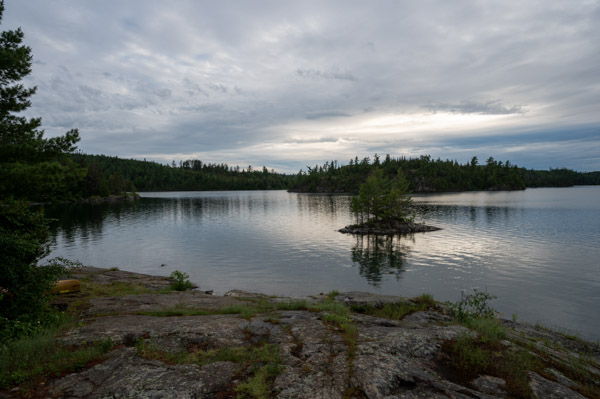
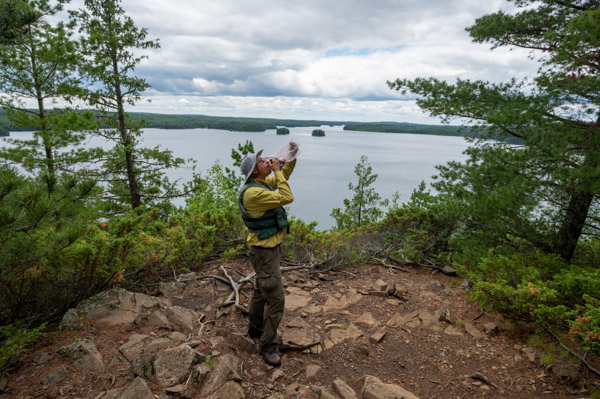
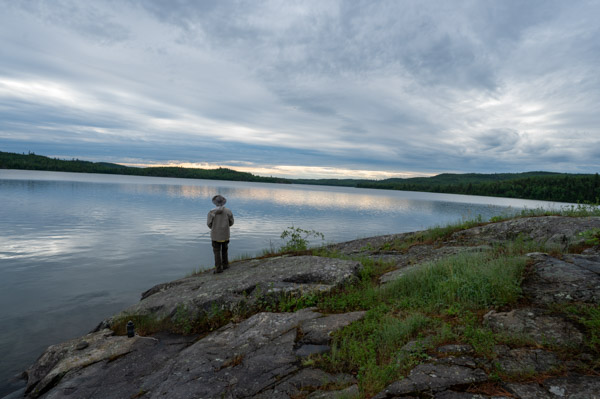
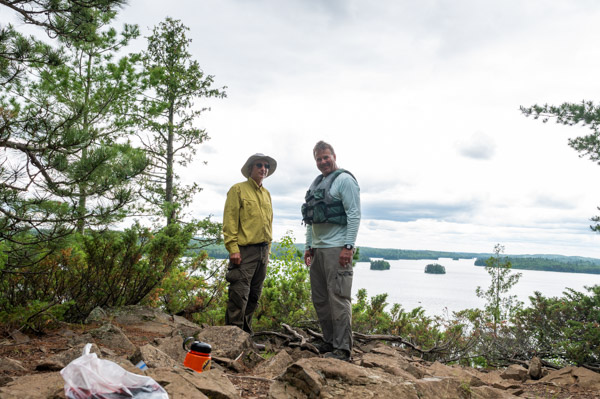
Second night in camp on South Arm Knife Lake
Dinner that night was provided by the Boundary Waters. When we got back to camp, we headed out to do some fishing in the canoe. I caught a nice bass, and Rick caught a walleye. That brings me to some thoughts on fishing in the Boundary Waters. It’s incredible! A true fishing paradise. I realized that one of the reasons it’s difficult to find campsites is that groups will make their way out to the most popular lakes, perhaps those with the best fishing, and then set up a base camp for an extended period. We witnessed that many times. As day travelers, we were competing with these established groups for sites. Rick prepared our catch and then fried it for an excellent fresh fish dinner.


Fourth day in the Boundary Waters – Heading to Ogish
Spectacular very early morning Boundary Water scenes


I awoke early the following day (4:30 AM) to a colorful glow on my semi-translucent Zpacks Triplex tent. The sunrise that morning was spectacular, the most beautiful on our trip. The sun comes up early in the Boundary Waters in mid-June! Our 4th day was going to be a heavy travel day with many portages. From South Arm, we would portage into Eddy Lake. Then another portage into Jenny Lake and finally another into Ogishkemuncie Lake (‘Ogish’). Ogish is where we would start searching for a campsite. We planned to arrive early enough that if we couldn’t find a site, we could continue into other lakes until we did find one. By the 4th day, we were starting to learn how to travel in the Boundary Waters!
Waterfall and portage into Eddy Lake
Just as we got started on the first portage of the day, into Eddy Lake, we came upon a beautiful waterfall in a jungle-like setting. It was cool! A group of mostly younger kids was crawling all over the falls, some well above it in a sketchy spot. I didn’t want to be the one getting video of the kids going over the falls! We took some time capturing the scene, including a group shot in front of the waterfall. After our fun at the falls was completed, the portage continued. The falls were lovely, but that portage was not. It was a beast of a steep climb on a rocky and rough trail. Our portage ‘strategy’ at that point had firmed up. First, Rick strapped on the smaller backpack. Then I picked up the back of the canoe, keeping the front on the ground.



Rick then went under the canoe locating himself beneath the carry pads. I strapped on the Duluth pack, smaller day pack, grabbed the oars, and picked up everything else. At the end of each portage, Rick would put the canoe in the water and stow the backpack. I’d put everything else in; we’d get in and paddle off. It became a very efficient process.
Eddy Lake to Ogishkemuncie Lake
We survived the portage and started the short paddle across Eddy Lake. Almost immediately, we began the portage into Jenny Lake. By this time in the trip, our portages were all single and quite efficient. Paddling quickly across Jenny Lake we approached the final portage of the day into Ogishkemuncie Lake. The skies had started to clear, the sun was out, and the day had become quite pleasant. Our paddling muscles were in full stride by now, and the travel that day was enjoyable. We made it into Ogish, a large lake reminiscent of the big water Saganaga on our first day, and started searching for a campsite.
Every camp we came to in Ogishkemuncie was occupied. There would be no repeat of our campsite good fortunes in South Arm. We had no choice but to press on. But the day was lovely, we had planned well and arrived early, and our spirits remained high. We passed a pretty little waterfall, and not long after that, we came to a group going the other way. They told us of an open campsite not far ahead in an area known as ‘The Narrows.’ It was a spot where the lake narrowed to about 50 feet wide as it rounded a bend. Our paddling quickened, and we soon arrived to find an unoccupied 4-star campsite. That camp at The Narrows became one of our favorites of the trip.
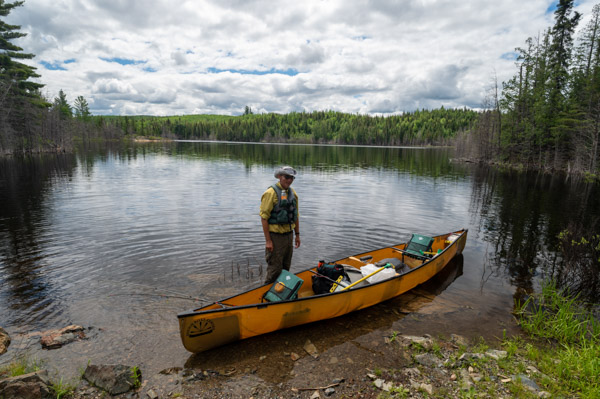



Awesome campsite at ‘The Narrows’ on Ogishkemuncie
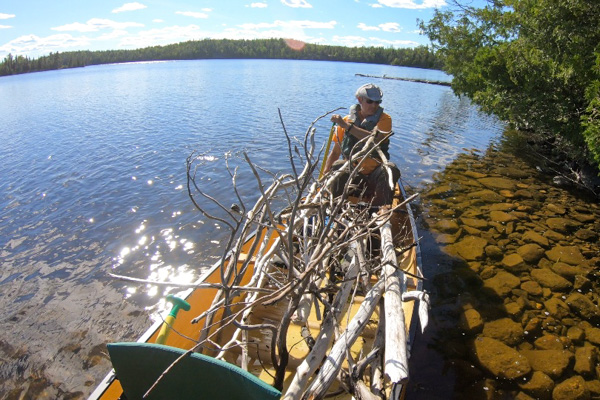
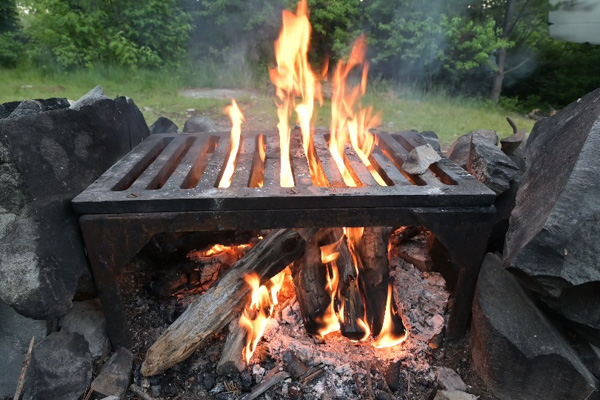
Our camp at The Narrows was the ideal spot to watch all the canoes pass. A couple that stopped on our camp’s shore told us the campsite we were in was their favorite in the Boundary Waters. We felt lucky to be there, and it speaks to the luck required to find campsites in the Boundary Waters. The site was popular, so there was no firewood to be located anywhere near our site. We solved the problem by using the canoe to haul driftwood from along the shore back to camp. By that point in the trip, our supply of ‘real’ food was just about depleted. But we still had some canned Spam left. Maybe it wasn’t up to the level of the steak dinner from the first night, but on that 4th night, it sure tasted good.
We supplemented the Spam with a satisfying Mountain House chicken, mashed potatoes, and gravy dinner. It reminded me of a Thanksgiving turkey dinner. After dinner, the sunset view looking down the mirror-like channel from our camp was spectacular. It was one of the most beautiful and peaceful of our entire trip.

Fifth day in the Boundary Waters – heading to Seagull Lake
Long day of paddling to Seagull – the last portages
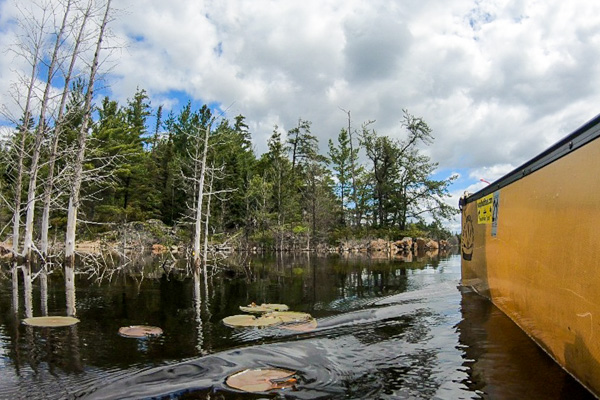
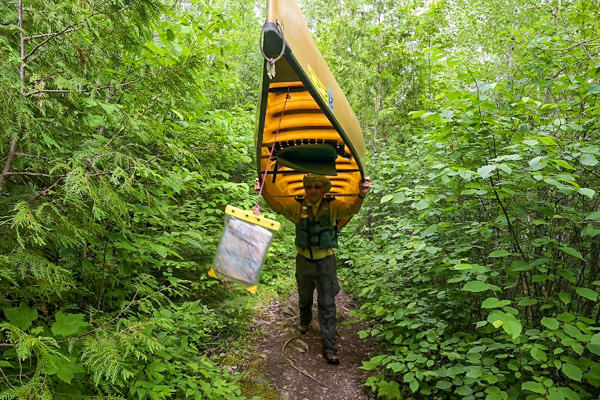
The trip was coming to an end. There was just one more night of camping on Seagull Lake remaining. But the second to last day of paddling was going to be a long one, with the most portages of any single day. From the end of Ogishkemuncie Lake, we would portage into Kingfisher Lake. Then we would portage into Jasper Lake almost immediately after arriving at Kingfisher. A bit longer paddle on Jasper Lake would get us to our third portage of the day into Alpine Lake. There would be several miles of paddling on Alpine Lake before the final portage of our Boundary Waters trip. The last portage would also be our longest. It would be a half-mile portage into Seagull Lake. Fortunately, the portage was relatively flat and smooth.
Searching for a campsite on Seagull Lake
Once we made it to Seagull Lake, we immediately began the search for our last campsite. Since the outfitter was on Seagull, we were concerned about finding a campsite. Luckily, the second campsite we came to was unoccupied. It was a great site sitting on a small cliff above the lake, with a great view of the lake. Our good luck was back!

Enjoying the afternoon in our last Boundary Waters campsite


We made the most of our last night in the Boundary Waters. The skies had cleared, and the sun was warm as we relaxed on the rocks next to camp. I went for my first swim on the trip. It felt refreshing to let the lake water rinse some of the grime off. Later in the afternoon, we returned to the canoes for one final fishing and exploration cruise. The winds had picked up substantially, and the water was as rough as we had experienced on the trip. But I felt oddly comfortable in the canoe in the harsh conditions. It was quite a contrast from how I felt on the first day. Dinner was an array of everything we had left in our food bags. After dinner, we sat on the rocks soaking up the view of Seagull Lake one last time.
Last day in the Boundary Waters – to Seagull Outfitter
It was an early start the last morning. Overnight, the winds had picked up substantially, and we were concerned about the conditions on Seagull Lake if the weather deteriorated further. Fortunately, the winds were straight behind us and around 20 MPH. As a result, the water was as rough as any we had experienced, but the canoe sped back to the Seagull Outfitter at over 4 MPH. We turned into a bay where we thought the outfitter was, but it was the wrong bay. We got to the end, and no outfitter! Maps were hastily pulled out, we realized our mistake, turned around, and found the correct bay. We ran into multiple groups just getting started. The Seagull Outfitter came into view shortly, and our Boundary Waters trip was over.


Conclusion – Boundary Waters Canoe Area Wilderness
It was one of those trips where I wished I had the experience at the beginning that I ultimately had at the end. The first few days were uncomfortable as I adjusted to multi-day travel by canoe. I was awkward and tense, and my paddling muscles were not yet conditioned. I was amazed at the difference after only six days. By the end, even the roughest water didn’t phase me, and I could paddle non-stop for hours. I had no idea what to expect going into the trip, but it was all I could have hoped for.
We eventually completed the trip as planned. Excellent campsites were found on each lake where we had hoped to camp, and we enjoyed some great fishing and fish dinners. The weather had run the spectrum from clear and sunny to cloudy, gloomy, and rainy, all the way to squall-line thunderstorms. Fortunately, we were able to ride out the worst weather in camp under a tarp, though we witnessed many others who weren’t nearly as lucky. The end of the trip left me satisfied that we accomplished what we set out to do. But it also filled me with anticipation for the next trip to the Boundary Waters Canoe Area Wilderness.
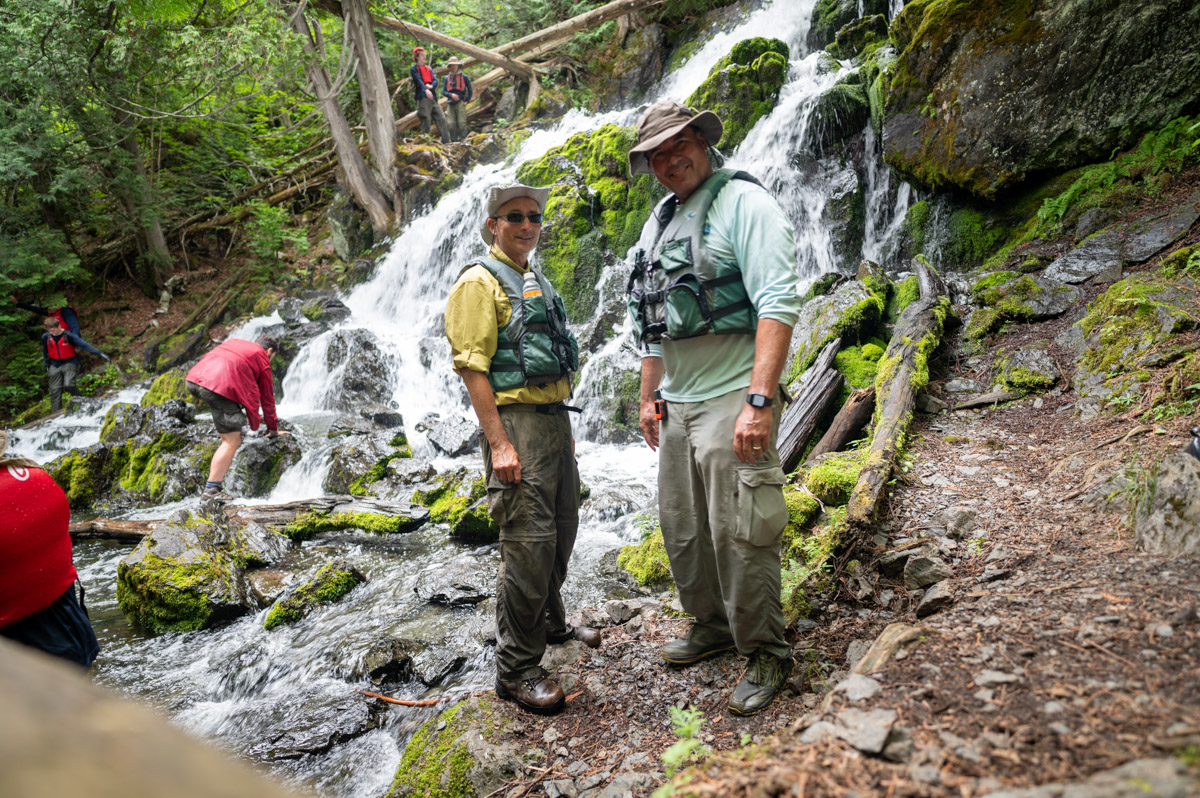
Group shot at Eddy Lake portage waterfall
